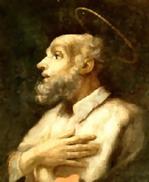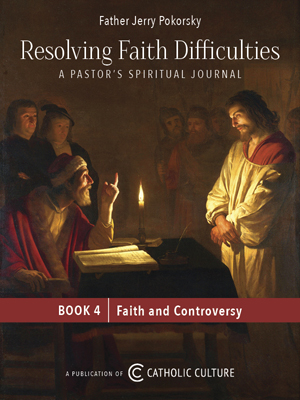To Pray Always: the Liturgy of the Hours
by Mary Bazzett
The Liturgy of the Hours is further proof of the Catholic Church's deep Jewish roots. Formerly more commonly known as the "Divine Office" or "breviary," these prayers have a long and venerable history that stretches back to apostolic times.
In the early days of the Church, the first Christians were Jewish, and the Acts of the Apostles depicts them not only participating in the breaking of the bread, but also going to the synagogue and Temple to worship. This included traditional prayer services at the third, sixth and ninth hours of the day, our 9 o'clock in the morning, noon and 3 o'clock in the afternoon.
Pentecost—the Holy Spirit descending on the apostles—was at the third hour (Acts 2:15). Peter prayed on the housetop at the sixth hour (Acts 10:9). And Peter and John went to the Temple to pray at the ninth hour (Acts 3:1).
These hours of prayer were adopted by the early Christians and correspond to prayer times for what was later called the Divine Office, specifically to Terce, Sext and None, respectively (coming from the Latin for third, sixth and ninth).
But the Divine Office's major hours for prayer were morning and evening "Lauds" and "Vespers"—which corresponded to the morning and evening sacrifice in the Temple.
The early Christians adopted these two times which, since then, have been principal daily periods of prayer. In fact, at the Second Vatican Council (1962-1965), they were called the "two hinges upon which the daily office turns." That's why "they are to be considered as the chief hours."
The word Lauds literally means "the praises." The name comes from the last three psalms (148-150, known as the "laudate psalms") which—for centuries—were prayed each morning. Among the themes of Vespers is "the evening sacrifice." Psalm 140 reads, "Let my prayer rise like incense before you, the lifting of my hands like an evening sacrifice," referring to Jewish Temple worship.
Because of their belief in Christ, the early Christians eventually were expelled from the Temple and synagogues. That was when they developed their own prayers around the same times, said individually or in common, to sanctify the hours of the day and night. In this way, the early Church obeyed Christ's directive to "pray always and never lose heart" (Lk 18:1), as well as St. Paul's exhortations to "pray always" (1 Thes 5:17), and "with gratitude in your hearts sing psalms and hymns and inspired canticles to God" (Col 3:16).
From earliest times, the Church has done exactly that, using psalms and other biblical texts. The best known of these is the prayer of Christ himself, the Our Father, which the Didache, an early Church document, instructed Christians to say three times a day.
But they prayed not only during the day but also at night. Paul and Silas prayed and sang songs of praise to God in prison at midnight (see Acts 16:25). This time of prayer corresponds to matins, originally prayed between the first and second hour of the day, or midnight and 1 a.m. The theologian Tertullian (c.160-c.222) advised Christian women to be careful to marry men who also were Christians, because pagan men would not understand their getting up in the middle of the night to praise God.
The history of the early Church's prayer times is difficult to follow after the first century, largely due to the periodic destruction of documents during persecutions. By the fourth century, however, under the Roman emperor Constantine (d. 337), practices of the faith—including communal daily prayers—became legal and, because of that, public. The persecution of Christians had ended, and the faithful found themselves free to gather without fear around their bishop for what became known as the "cathedral office."
This name comes from the Greek word "cathedra," meaning seat. It referred to the official seat that a bishop occupied, symbolizing his teaching authority. (Today a diocese's cathedral has a special chair for its bishop.) Since lay people had daily work and families to care for, the cathedral office was by necessity brief, consisting of perhaps a psalm, antiphon (short verse from a psalm or sentence from the Bible), Scripture reading, homily and intercessions.
A later development was the "monastic office." The rise of the monastic movement —first with the desert Fathers and later with Western monastic orders, such as the Benedictines—resulted in a much longer and more elaborate Divine Office. (St. Benedict, the "father of Western monasticism," died around 550.) Monks had more time than lay people for formal prayer and their early offices were very lengthy, the entire 150 psalms being prayed every day in some cases.
Over time, the cathedral office as a communal liturgical celebration died out in the Western Church. Monasteries in urban centers became closer to the dominant influence on liturgical development, and the office consequently became the long, complex monastic office. It was seen more and more as the exclusive duty of priests and Religious, and among the former was not usually prayed in common. The increased demands of clerics in the Middle Ages made the need for a shorter, reformed office evident.
In "monasteries, it was common for monks to use a number of large books for the Divine Office. They might have a psalter (book of psalms), another book for antiphons, a Bible, a hymn book and yet another volume containing the non-scriptural readings required. This worked fine for clerics who lived and prayed in one location, but the newer, more mobile clerics, such as the Franciscans, needed to travel light. (St. Francis of Assisi, founder of the Franciscans, died in 1226.) For them the Vatican devised a condensed version of the office. Its name—"breviary"—comes from the Latin word for "abbreviated." The Franciscans spread the use of the breviary throughout Europe and beyond.
Over time, the breviary came to be regarded more as a prayer book for Religious than as a liturgical form of prayer for the whole Church.
The reform of the Liturgy of the Hours has been ongoing since the 1500s, with Pope Pius X utilizing the liturgical-renewal movement, and the Second Vatican Council eventually revising and streamlining the office, resulting in a simpler, more flexible liturgy.
Canon law still requires priests to recite the Liturgy of the Hours each day: Lauds, Vespers and three other sets of prayer.
Now those two major "hinge" prayers include an "invitatory" psalm, a hymn, the reading of a number of psalms and a passage from Scripture (which vary depending on the liturgical season), the Our Father, antiphons, intercessions, a blessing and dismissal. Lauds has the Canticle of Zechariah (from Lk 1:68-79) and Vespers has the Magnificat (based on Lk 1:46-55).
Since the council, the Church has reaffirmed the public, communal nature of the Liturgy of the Hours as the prayer of the entire Church and has underlined the need for lay participation in it. (One-volume editions, and even shorter versions of the office, are available in Catholic bookstores.)
In fact, since the revision of the Divine Office after Vatican II, lay people have been encouraged to participate in the Liturgy of the Hours, either with the priest, among themselves or even individually.
When they do, they join with the entire Church throughout the world in its common prayer, sanctifying the day and night, giving praise and worship to God in a rich and beautiful tradition of our Catholic heritage.
Mary Bazzett writes from Combermere, Ontario, where she is editing the writings of Catherine De Hueck Doherty, foundress of the Madonna House Lay Apostolate.
Catholic Heritage, Our Sunday Visitor, 200 Noll Plaza, Huntington, IN 46750-1696
This item 264 digitally provided courtesy of CatholicCulture.org






